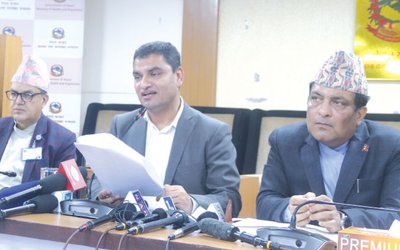On Aug9, 2014,the eve of JanaiPurnima, Gosainkunda lake ( 4300m)will be the venue for the climactic enactment of the greatest Vedic story. In their quest for amrit( the elixir for spiritual immortality), the titans and the gods collaborated in churning the ocean. Mount Mandara was selected as the churning stick, Vasuki the king of serpents, would be the churning rope, and Vishnu himself in the form of a tortoise dove into the ocean to support with his back the base of the mountain. After Vasuki had been wrapped around the mountain, the titans laid hold of one end of the rope and the gods the other. They churned for a thousand years.
Unfortunately from the murky depths of the ocean, the first thing to rise was Kalakut, a deadly poison.The operation could not proceed further until someone drank this concoction. Lord Shiva who was in the neighbourhoodshookhimself from his deep meditation, surveyed the scene, and swallowed the poison in one gulp. His throat promptly turned blue ( Nilakhanta, Blue Throat, is another name for Shiva). He needed to cool off the immense heat generated by Kalakut; so he dove into Gosainkunda Lake. In the memory of this selfless act by Lord Shiva, pilgrims annually take a holy dip in the lake and wash away their sins. But just like for the great Shiva, this pilgrimage is not risk free.
Some years ago, because many pilgrims to Gosainkunda suffer from acute mountain sickness ( AMS) due to very rapid ascents ( for example, manypilgrims despite strong advice, do the trip in 2 days instead of the recommended 4 or 5 days), we carried out a double blind, randomized controlled trial to see if diamox ( the most commonly used drug for the prevention of AMS) would be helpful in these rapid ascends. Although there are proper studies of high dosediamox ( 750 mg) which show effectiveness of this drug in the prevention of AMS, there are no studies of low dose Diamox (125 mg two times a day) in rapid ascents.
Imagine our surprise and dismay when we found out that the study revealed results which were very confusing and almost uninterpretable. What went wrong? Apparently, pilgrims were not following simple directions regarding the study, and some were even exchanging study pills with their fellow pilgrims. Clearly we had not spent enough time counselling the pilgrims about the importance of following directions in a medical study. This sort of problem is something we rarely encounter in these numbers when we study western trekkers in randomized controlled trials in the Himalayas. Hence the finding of the Gosainkundadiamox trial became more of a study in cultural mores than an actual scientific trial as we had planned.
Starting from Dunche in Rasuwa district, it is best to take 4 to 5 nights to reach the lake so that you are properly acclimatized. You need to listen to your body and not push ahead relentlessly disregarding symptoms of acute mountain sickness which are chiefly headache and nausea. Volunteers with accurate knowledge of altitude sickness from the Himalayan Rescue Association and the Mountain Medicine Society of Nepal will also be at hand to help you. Taking diamox, if you don’t have sulpha allergy, will help to prevent and treat AMS. Drinking 2 liters of clean water ( boiled or treated with chlorine/iodine tablets) per day will help avoid dehydration. Proper rain gear and carrying some table salt to deal with leech bites will come in handy. The lake area is completely packed during JanaiPurnima so being psychologically prepared for some of the hardship will help. But you will be amply rewarded for your efforts.

Buddha Basnyat MD
Buddha Basnyat, MD, MSc, FACP, FRCP, Director of the Oxford University Clinical Research Unit-Patan Academy of Health Sciences, Kathmandu.
- Altitude Sickness
- Feb 20, 2018
- Post-earthquake Nepal: The Way Forward
- Dec 13, 2015
- The Annapurna Sanctuary
- Nov 29, 2015
- Diarrhea at the Summit
- Nov 08, 2015
- Altitude Sickness ( AMS, HAPE, HACE)
- Oct 15, 2015















